Potrebujeme váš súhlas na využitie jednotlivých dát, aby sa vám okrem iného mohli ukazovať informácie týkajúce sa vašich záujmov. Súhlas udelíte kliknutím na tlačidlo „OK“.
ASTM D1304-99(2012)
Standard Test Methods for Adhesives Relative to Their Use as Electrical Insulation
Automaticky preložený názov:
Štandardné skúšobné metódy pre lepidlá v pomere k ich použitie ako elektrotechnická izolácia
NORMA vydaná dňa 1.10.2012
Informácie o norme:
Označenie normy: ASTM D1304-99(2012)
Poznámka: NEPLATNÁ
Dátum vydania normy: 1.10.2012
Kód tovaru: NS-16933
Počet strán: 4
Približná hmotnosť: 12 g (0.03 libier)
Krajina: Americká technická norma
Kategória: Technické normy ASTM
Kategórie - podobné normy:
Anotácia textu normy ASTM D1304-99(2012) :
Keywords:
adhesives, arc resistivity, d-c conductivity, dielectric strength, electrical insulation, power factor, surface resistivity, volume resistivity, ICS Number Code 83.180 (Adhesives)
Doplňujúce informácie
| Significance and Use | |||||||||||||||||||||
|
4.1 Insulating materials are used to isolate components of an electrical system from each other and from ground, as well as to provide mechanical support for the components. For this purpose, it is generally desirable to have the insulation resistance as high as possible, consistent with acceptable mechanical, chemical, and heat-resisting properties. Since insulation resistance or conductance combines both volume and surface resistance or conductance, its measured value is most useful when the test specimen and electrodes have the same form as is required in actual use. Surface resistance or conductance changes rapidly with humidity, while volume resistance or conductance changes slowly although the final change may eventually be greater. 4.2 Resistivity or conductivity is used to predict, indirectly, the low-frequency dielectric breakdown and dissipation factor properties of some materials. Resistivity or conductivity is often used as an indirect measure of moisture content, degree of cure, mechanical continuity, and deterioration of various types. The usefulness of these indirect measurements is dependent on the degree of correlation established by supporting theoretical or experimental investigations. A decrease of surface resistance will result either in an increase of the dielectric breakdown voltage because the electric field intensity is reduced, or a decrease of the dielectric breakdown voltage because the area under stress is increased. 4.3 All the dielectric resistances or conductances depend on the length of time of electrification and on the value of applied voltage (in addition to the usual environmental variables). These must be known to make the measured value of resistance or conductance meaningful. 4.4 Volume resistivity or conductivity is used as an aid in designing an insulator for a specific application. The change of resistivity or conductivity with temperature and humidity may be great, and must be known when designing for operating conditions. Volume resistivity or conductivity determinations are often used in checking the uniformity of an insulating material, either with regard to processing or to detect conductive impurities that affect the quality of the material and that may not be readily detectable by other methods. 4.5 Volume resistivities above 1021 Ω·cm (1019 Ω·m), obtained on specimens under usual laboratory conditions, are of doubtful validity, considering the limitations of commonly used measuring equipment. 4.6 Surface resistance or conductance cannot be measured accurately, only approximated, because some degree of volume resistance or conductance is always involved in the measurement. The measured value is also affected by the surface contamination. Surface contamination, and its rate of accumulation, is affected by many factors including electrostatic charging and interfacial tension. These, in turn, may affect the surface resistivity. Surface resistivity or conductivity can be considered to be related to material properties when contamination is involved but is not a material property in the usual sense. |
|||||||||||||||||||||
| 1. Scope | |||||||||||||||||||||
|
1.1 These test methods cover procedures for testing adhesives in liquid, highly viscous, solid, or set states, that are intended to be cured by electronic heating, or that are intended to provide electrical insulation, or that are intended for use in electrical apparatus. 1.2 The procedures appear in the following order: (1) Procedure for Testing Adhesives Before Use:
(2) Procedures for Testing Properties of Adhesives As Used:
1.3 This standard does not purport to address all of the safety concerns, if any, associated with its use. It is the responsibility of the user of this standard to establish appropriate safety and health practices and determine the applicability of regulatory limitations prior to use. For a specific hazard statement, see 8.2. |
|||||||||||||||||||||
| 2. Referenced Documents | |||||||||||||||||||||
|
Podobné normy:
Historická
1.5.2007
Historická
1.5.2007
Historická
1.3.2014
Historická
1.7.2013
Historická
1.10.2013
Historická
1.10.2012


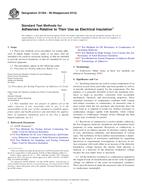
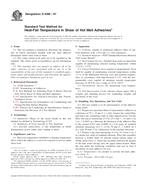 ASTM D4498-07
ASTM D4498-07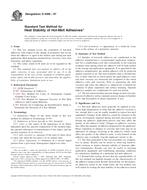 ASTM D4499-07
ASTM D4499-07 ASTM D4501-01(2014)..
ASTM D4501-01(2014)..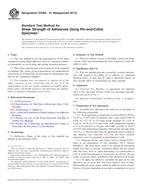 ASTM D4562-01(2013)..
ASTM D4562-01(2013)..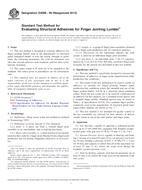 ASTM D4688-99(2013)..
ASTM D4688-99(2013)..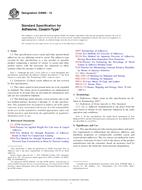 ASTM D4689-12
ASTM D4689-12
 Cookies
Cookies
